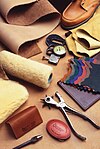Artificial leather
Artificial leather, also called synthetic leather is a material intended to substitute for leather in upholstery, clothing, footwear, and other uses where a leather-like finish is desired but the actual material is cost-prohibitive or unsuitable. Artificial leather is marketed under many names, including "leatherette", "faux leather", "vegan leather", "PU leather" and "pleather".[1]
Contents
1 Manufacture
2 Environmental impact
3 Clothing and fabric uses
4 Brand names
5 See also
6 References
Manufacture

Steps to make synthetic polyurethane leather:
1) The base fabric
2) A polyurethane coating is applied
3)A color coat is added
4) A textured finish is added[2]
Many different methods for the manufacture of imitation leathers have been developed.
One of the earliest was Presstoff. Invented in 19th century Germany, it is made of specially layered and treated paper pulp. It gained its widest use in Germany during the Second World War in place of leather, which under wartime conditions was rationed. Presstoff could be used in almost every application normally filled by leather, excepting items like footwear that were repeatedly subjected to flex wear or moisture. Under these conditions Presstoff tends to delaminate and lose cohesion.
Poromerics are made from a plastic coating (usually a polyurethane) on a fibrous base layer (typically a polyester). The term poromeric was coined by DuPont as a derivative of the terms porous and polymeric. The first poromeric material was DuPont's Corfam, introduced in 1963 at the Chicago Shoe Show. Corfam was the centerpiece of the DuPont pavilion at the 1964 New York World's Fair in New York City. After spending millions of dollars marketing the product to shoe manufacturers, DuPont withdrew Corfam from the market in 1971 and sold the rights to a company in Poland.
Leatherette is also made by covering a fabric base with a plastic. The fabric can be made of natural or synthetic fiber which is then covered with a soft polyvinyl chloride (PVC) layer. Leatherette is used in bookbinding and was common on the casings of 20th century cameras.
Cork leather is a natural-fiber alternative made from the bark of cork oak trees that has been compressed, similar to Presstoff.[3]
A fermentation method of making collagen, the main chemical in real leather, is under development.[4]
Environmental impact
The production of the PVC used in the production of many artificial leathers requires a plasticizer called a phthalate to make it flexible and soft. PVC requires petroleum and large amounts of energy thus making it reliant on fossil fuels. During the production process carcinogenic byproducts, dioxins, are produced which are toxic to humans and animals.[5] Dioxins remain in the environment long after PVC is manufactured. When PVC ends up in a landfill it does not decompose like genuine leather and can release dangerous chemicals into the water and soil.
Polyurethane is currently more popular for use than PVC.[6]
Clothing and fabric uses

Queen Paola of Belgium wearing artificial leather
Artificial leathers are often used in clothing fabrics, furniture upholstery, and automotive uses.[7] One disadvantage of plastic-coated artificial leather is that it is not porous and does not allow air to pass through; thus, sweat can accumulate if it is used for clothing, car seat coverings, etc. One of its primary advantages, especially in cars, is that it requires little maintenance in comparison to leather, and does not crack or fade easily.[7]
Brand names

1968 Mercedes Benz 280SE (W108) Seats and door trim in Blue MB-Tex
Clarino: manufactured by Kuraray Co., Ltd. of Japan.
Fabrikoid: a DuPont brand, cotton cloth coated with nitrocellulose
- Lorica: manufactured by Lorica Sud, an Italian tannery[8]
- MB-Tex: Used in many Mercedes-Benz base trims[9]
Naugahyde: An American brand introduced by Uniroyal
Rexine: a British brand
Kirza: A Russian form developed in the 1930s consisting of cotton fabric, latex, and rosin
Piñatex: made from pineapple leaves- Paguro: made from recycled rubber[10]
- MuSkin: made from mushrooms that are treated non-chemically to become water resistant[11]
- Kantala: Sri Lanken company specializing in leather made from the hana plant (agave plant)[12]
See also
| Wikimedia Commons has media related to Artificial leather. |
Bicast leather – a form of genuine leather coated with a plastic finish
Bonded leather – a material made by blending scrap leather fibers with a plastic binder
Microfiber – a material made with synthetic fibers thinner than natural silk; can be used for making synthetic suedes, like Ultrasuede
References
^ Claire Shaeffer (10 November 2003). Sew Any Fabric: A Quick Reference to Fabrics from A to Z. Krause Publications Craft. p. 37. ISBN 1-4402-2033-6..mw-parser-output cite.citation{font-style:inherit}.mw-parser-output .citation q{quotes:"""""""'""'"}.mw-parser-output .citation .cs1-lock-free a{background:url("//upload.wikimedia.org/wikipedia/commons/thumb/6/65/Lock-green.svg/9px-Lock-green.svg.png")no-repeat;background-position:right .1em center}.mw-parser-output .citation .cs1-lock-limited a,.mw-parser-output .citation .cs1-lock-registration a{background:url("//upload.wikimedia.org/wikipedia/commons/thumb/d/d6/Lock-gray-alt-2.svg/9px-Lock-gray-alt-2.svg.png")no-repeat;background-position:right .1em center}.mw-parser-output .citation .cs1-lock-subscription a{background:url("//upload.wikimedia.org/wikipedia/commons/thumb/a/aa/Lock-red-alt-2.svg/9px-Lock-red-alt-2.svg.png")no-repeat;background-position:right .1em center}.mw-parser-output .cs1-subscription,.mw-parser-output .cs1-registration{color:#555}.mw-parser-output .cs1-subscription span,.mw-parser-output .cs1-registration span{border-bottom:1px dotted;cursor:help}.mw-parser-output .cs1-ws-icon a{background:url("//upload.wikimedia.org/wikipedia/commons/thumb/4/4c/Wikisource-logo.svg/12px-Wikisource-logo.svg.png")no-repeat;background-position:right .1em center}.mw-parser-output code.cs1-code{color:inherit;background:inherit;border:inherit;padding:inherit}.mw-parser-output .cs1-hidden-error{display:none;font-size:100%}.mw-parser-output .cs1-visible-error{font-size:100%}.mw-parser-output .cs1-maint{display:none;color:#33aa33;margin-left:0.3em}.mw-parser-output .cs1-subscription,.mw-parser-output .cs1-registration,.mw-parser-output .cs1-format{font-size:95%}.mw-parser-output .cs1-kern-left,.mw-parser-output .cs1-kern-wl-left{padding-left:0.2em}.mw-parser-output .cs1-kern-right,.mw-parser-output .cs1-kern-wl-right{padding-right:0.2em}
^ "PU Synthetic Leather". Gofar Synthetic Co., Ltd. Archived from the original on 11 May 2005. Retrieved 11 May 2005.
^ Oskar, Zieba (5 July 2017). "Cork Leather – The Best Alternative to Animal Leather?". Blackwood Blog. Archived from the original on 3 August 2017. Retrieved 3 August 2017.
^ Kolodny, Lora (2018-03-09). "This leather is made in a lab, not from livestock". CNBC. Retrieved 2018-10-13.
^ US EPA, ORD (2014-01-28). "Learn about Dioxin". US EPA. Retrieved 2018-12-17.
^ "Vegan Leather Isn't As Ethical As You Think". Vocativ. 2016-02-10. Retrieved 2018-12-17.
^ ab Blesius, Jim (April 7, 2014). "What is Faux Leather?". Retrieved August 22, 2018.
^ The Lorica "concept": Lorica Sud
^ "What is MB-Tex Seat Upholstery? - MB-Tex vs. Leather". www.loebermotors.com. Retrieved 7 April 2018.
^ "Paguro Upcycle". Paguro Upcycle. Retrieved 2018-12-17.
^ "Muskin, the vegetable leather made from mushrooms". LifeGate. 2016-11-21. Retrieved 2018-12-17.
^ "Kantala - Handmade Ethical Fashion Accessories". Kantala. Retrieved 2018-12-17.
Faux Real: Genuine Leather and 200 Years of Inspired Fakes, by Robert Kanigel. Joseph Henry Press, 2007.
